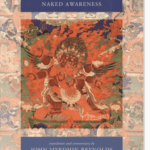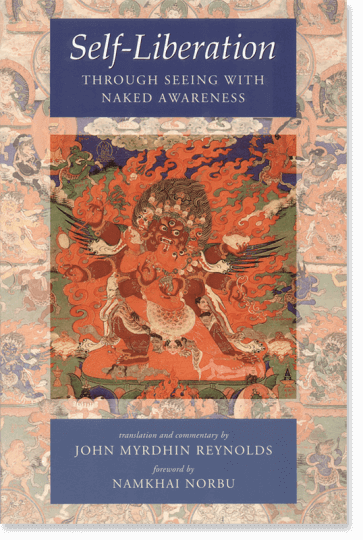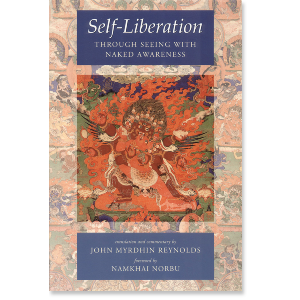| The following article is from the Autumn, 2000 issue of the Snow Lion Newsletter and is for historical reference only. You can see this in context of the original newsletter here. |
by John Myrdhin Reynolds
fore, by Namkhai Norbii
171 pp., 4 line drawings, glossary,
biblio., index. #SELI $14.95
A text belonging to the same cycle as The Tibetan Book of the Dead, this instruction on the method of self-liberation presents the essence of Dzogchen, the Great Perfection, regarded in Tibet as the highest and most esoteric teaching of the Buddha
Teaching the attainment of Buddhahood in a single lifetime, this text was written and concealed by Guru Padmasambhava in the eighth century and rediscovered six centuries later by Karma Lingpa. The commentary by the translator is based on the oral teachings of Namkhai Norbu Rinpoche and Lama Tharchin Rinpoche.
If you understand intrinsic awareness, all of your merits and sins will be liberated into their own condition.... If he practices, then even a cowherd can realize liberation.
JOHN MYRDHIN REYNOLDS (Vajra- natha) is a writer, teacher, translator, and scholar/practitioner of Tibetan Buddhism. He was trained and ordained as a Tantric Yogin, or Ngagpa, in the Nyingmapa tradition of Tibetan Buddhism. He has taught widely in the United States and Europe. He is also the author of The Golden Letters.
Foreword
by Namkhai Norbu Rinpoche
In the eighth century of our era, the master from the country of Uddi- yana, Guru Padmasambhava, who was the individual principally responsible for establishing the teachings of the Buddhist Tantras in Tibet, gave to his group of disciples there many vast and profound teachings related to both Tantra and Dzogchen. But since the Tibetan people were not ready for all of these teachings, many of which were more directly suited to future generations, he had his consort, the Tibetan princess Yeshe
Tsogyal, write them down and hide them in various places throughout the country. Such deliberately concealed texts are known as Termas or hidden treasures. Those among his original group of disciples who were reborn in later generations in order to rediscover these texts are known as Tertons, those who reveal hidden treasures. The appearance of Termas and Tertons during the following centuries, including the present one, has been a source of unending benefit and blessing for the Tibetan people and represents the continuing revelation of the highest teachings of the Tantras and Dzogchen.
In the fourteenth century of our era, there appeared a great Terton by the name of Nyida Sangye. His eldest son in turn became a great Terton by the name of Karma Lingpa. When he was fifteen years old, from a location on the mountain of Gam-po-dar, which looks like a dancing attendant deity, in eastern Dwagpo, he discovered many profound teachings, principally the Zob-chos zhi-khro dgongs pa rang-grol, otherwise known as the Kar-gling zhi-khro.
This cycle of texts of the Kar-gling zhi-khro represents an introduction to the state of Dzogchen, the Great Perfection. Dzogchen is not the name of a religion, philosophy, school, or sect but the Primordial State of the individual. The essence of the teachings of all the Buddhas is the understanding of this state, which is the nature of one's own mind. Among different schools this Primordial State has many different name Prajnaparimita, Tathagatagarbha, Bodhichitta, or Mahamudra. Among Tibetan Buddhists of the old school, the Nyingmapas, and also among the Bonpos, it is generally known as Dzogchen, which means the Great

...we first need transmission from a realized master in the form of an introduction (ngo-sprod) to the state of presence and awareness (rigpa), which is the capacity of the nature of mind. This introduction, a meeting face-to-face, is precisely the function of the present text, which reports the very words of Guru Padmasambhava.
Perfection. It is also called tha-mal gyi shes-pa, which means ordinary awareness; but this is not our ordinary mind incessantly thinking of this or that throughout the day. In Dzogchen we make a radical and fundamental distinction between mind (sems) and the nature of mind (sems nyid); and here ordinary awareness refers to the latter. The nature of the mind is like a mirror which has the natural and inherent capacity to reflect whatever is set before it, whether beautiful or ugly; but these reflections in no way affect or modify the nature of the mirror. It is the same with the state of contemplation: There is nothing to correct or alter or modify (ma bcos-pa). What the practitioner does when entering into contemplation is simply to discover himself in the condition of the mirror. This is our Primordial State. But in order to recognize it, we first need transmission from a realized master in the form of an introduction (ngo-sprod) to the state of presence and awareness (rigpa), which is the capacity of the nature of mind. This introduction, a meeting face-to-face, is precisely the function of the present text, which reports the very words of Guru Padmasambhava introducing his disciples to such presence or awareness. Hence this text, which is the root text of the Kar-gling zhi-khro cycle, is called Rig-pa ngo sprod. By means of Rigpa we come to see everything with a direct immediate presence, denuded of the judgments and conceptual constructions that usually obscure our vision and obstruct our understanding. And in this way, we come to realize self-liberation (rang grot). In the state of contemplation, when a thought arises, it is allowed to self-liberate into its own condition, without any effort or attempt at modification. Whereas the method of the Sutras is the path of renunciation and the method of the Tantras is the path of transformation, the method proper to Dzogchen is the path of selfliberation, as is made clear in the teaching of Padmasambhava that we have here. This text, the Rig-pa ngo-sprod gcer-mthong rang-grol, which is part of the cycle of the Zab-chos zhi-kbro dgongs-pa rang- grol, provides the essential view for this entire cycle of teachings relating to the six Bardos or intermediate states of existence. The Kar-gling zhi-khro is the most complete of all Zhi-khro (or Bardo) teachings and is widely known and used, especially among the Nyingmapa and the Kagyudpa schools. These teachings continue to generate activities for the benefit of beings, and in no way have they been exhausted.



